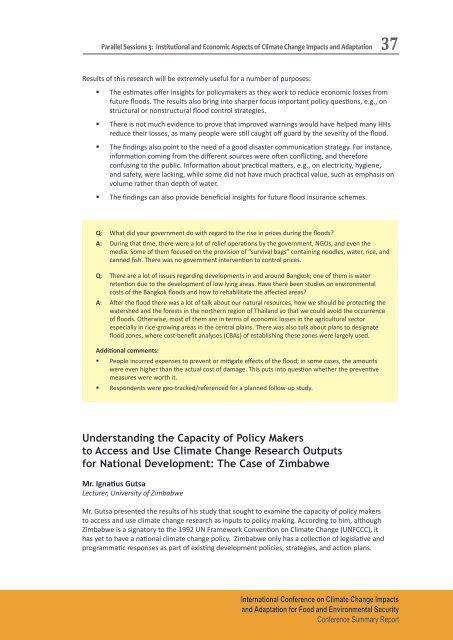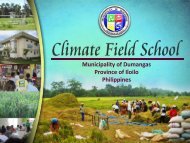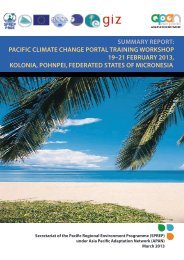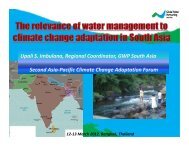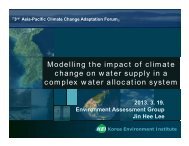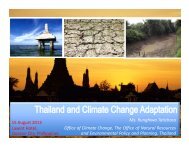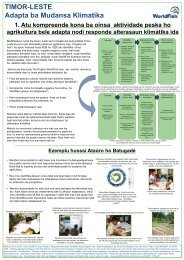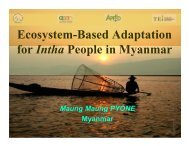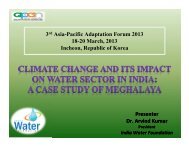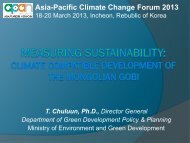PDF file (2.44 MB) - Asia Pacific Adaptation Network
PDF file (2.44 MB) - Asia Pacific Adaptation Network
PDF file (2.44 MB) - Asia Pacific Adaptation Network
Create successful ePaper yourself
Turn your PDF publications into a flip-book with our unique Google optimized e-Paper software.
Parallel Sessions 3: Institutional and Economic Aspects of Climate Change Impacts and <strong>Adaptation</strong>37Results of this research will be extremely useful for a number of purposes:• The estimates offer insights for policymakers as they work to reduce economic losses fromfuture floods. The results also bring into sharper focus important policy questions, e.g., onstructural or nonstructural flood control strategies.• There is not much evidence to prove that improved warnings would have helped many HHsreduce their losses, as many people were still caught off guard by the severity of the flood.• The findings also point to the need of a good disaster communication strategy. For instance,information coming from the different sources were often conflicting, and thereforeconfusing to the public. Information about practical matters, e.g., on electricity, hygiene,and safety, were lacking, while some did not have much practical value, such as emphasis onvolume rather than depth of water.• The findings can also provide beneficial insights for future flood insurance schemes.Q: What did your government do with regard to the rise in prices during the floods?A: During that time, there were a lot of relief operations by the government, NGOs, and even themedia. Some of them focused on the provision of “survival bags” containing noodles, water, rice, andcanned fish. There was no government intervention to control prices.Q: There are a lot of issues regarding developments in and around Bangkok; one of them is waterretention due to the development of low lying areas. Have there been studies on environmentalcosts of the Bangkok floods and how to rehabilitate the affected areas?A: After the flood there was a lot of talk about our natural resources, how we should be protecting thewatershed and the forests in the northern region of Thailand so that we could avoid the occurrenceof floods. Otherwise, most of them are in terms of economic losses in the agricultural sectorespecially in rice-growing areas in the central plains. There was also talk about plans to designateflood zones, where cost-benefit analyses (CBAs) of establishing these zones were largely used.Additional comments:• People incurred expenses to prevent or mitigate effects of the flood; in some cases, the amountswere even higher than the actual cost of damage. This puts into question whether the preventivemeasures were worth it.• Respondents were geo-tracked/referenced for a planned follow-up study.Understanding the Capacity of Policy Makersto Access and Use Climate Change Research Outputsfor National Development: The Case of ZimbabweMr. Ignatius GutsaLecturer, University of ZimbabweMr. Gutsa presented the results of his study that sought to examine the capacity of policy makersto access and use climate change research as inputs to policy making. According to him, althoughZimbabwe is a signatory to the 1992 UN Framework Convention on Climate Change (UNFCCC), ithas yet to have a national climate change policy. Zimbabwe only has a collection of legislative andprogrammatic responses as part of existing development policies, strategies, and action plans.International Conference on Climate Change Impactsand <strong>Adaptation</strong> for Food and Environmental SecurityConference Summary Report


